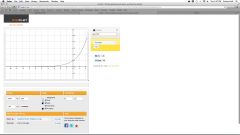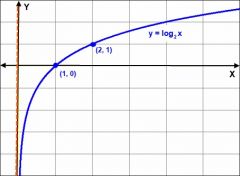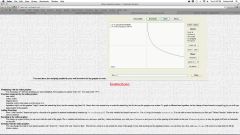![]()
![]()
![]()
Use LEFT and RIGHT arrow keys to navigate between flashcards;
Use UP and DOWN arrow keys to flip the card;
H to show hint;
A reads text to speech;
29 Cards in this Set
- Front
- Back
|
The inverses of exponential functions are called:
|
logarithmic functions
|
|
|
The inverse of the function f(x) = aˣ is:
|
logₐ(x)
|
|
|
logₐ(x) is read:
|
"log of x with base a"
|
|
|
the expression of logₐ(x) is called:
|
a logarithm
|
|
|
In general, log of x with base a =
|
the exponent that is used on the base a to obtain the value x.
|
|
|
What is the inverse of this function? f(3) = 2³ = 8
|
log₂(8) = 3
|
|
|
What is the definition of a log function?
|
For a > 0 and a ≠ 1, the logarithmic function with base a is denoted f(x) = logₐ(x), where logₐ(x) = y, IFF aʸ = x
|
|
|
What is the domain and range of the logarithmic function f(x) = logₐ(x)?
|
Since the function f(x) = logₐ(x) is the inverse of the function f(x) = aˣ, the Domain = (0,∞); the Range = (-∞,∞)
|
|
|
There are no logarithms of:
|
negative numbers or zero; meaning: no "log of -x with base a" or "log of 0 with base a."
|
|
|
Expressions such as log₂(-4) and log₃(0) are:
|
undefined
|
|
|
logₐ(1) =
|
0 for any base a, because a⁰ = 1 for any base a.
|
|
|
What two bases are used more frequently than others?
|
base 10 and base e.
|
|
|
How are log₁₀(x) and logₑ(x) abbreviated?
|
log₁₀(x) is abbreviated: log(x)
and logₑ(x) is abbreviated: ln(x) |
|
|
The Common Logarithmic function is denoted as:
|
f(x) = log(x), where log(x) = y IFF 10ʸ = x
|
|
|
The Natural Logarithmic function is denoted as:
|
f(x) = ln(x), where ln(x) = y IFF eʸ = x
|
|
|
The graph of y = aˣ has the __ -axis as its ____asymptote.
|
The graph of y = aˣ has the x-axis as its horizontal asymptote.
|
|
|
The graph of y = logₐ(x) has the __ -axis as its ____asymptote.
|
The graph of y = logₐ(x) has the y-axis as its vertical asymptote.
|
|
|
The function y = logₐ(x) is increasing if _______ and
decreasing if: |
The function y = logₐ(x) is increasing if a > 1
decreasing if a is between 0 and 1. |
|
|
The logarithmic function f(x) = logₐ(x) has the following properties:
|
1) The function f is increasing for a > 1 and decreasing for 0 < a < 1.
2) The x-intercept of the graph of f is (1, 0). 3) The graph has the y-axis as a vertical asymptote. 4) The domain of f is (0, ∞); the range is (-∞,∞) 5) The function is one-to-one. 6) The functions f(x) = logₐ(x) and f(x) = aˣ are inverse functions. |
|
|
The logarithmic family of functions is in the form:
|
g(x) = b • logₐ(x - h) + k
|
|
|
What is the one-to-one property of logarithms?
|
For a > 0 and a ≠ 1, if logₐ(x₁) = logₐ(x₂),
then x₁ = x₂. |
|
|
What are the steps to finding the inverse of a one-to-one function?
|
1) Replace f(x) with y.
2) Interchange x and y. 3) Solve the equation for y. 4) Replace y with f⁻¹(x). 5) Check that the domain of f is the range of f⁻¹ and and that the domain of f⁻¹ is the range of f. |
|
|
What is the formula for continuous compounding?
|
A = P•eʳᵗ
|
|
|
Describe the graph of f(x) = aˣ
|

|
|
|
Describe the graph of f(x) = -aˣ
|

|
|
|
Describe the graph of f(x) = (1/2)ˣ
|

|
|
|
Describe the graph of f(x) = -(1/2)ˣ
|

|
|
|
Describe the graph of f(x) = log₂(x)
|

|
|
|
Describe the graph of f(x) = -1•log₂(x)
|

|

